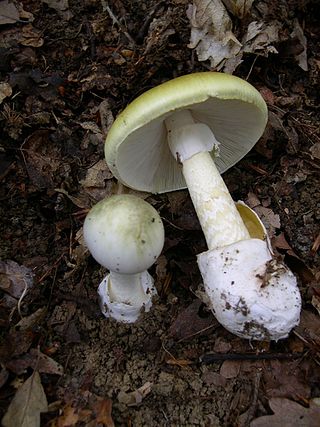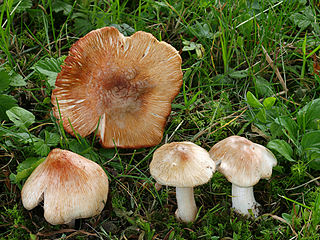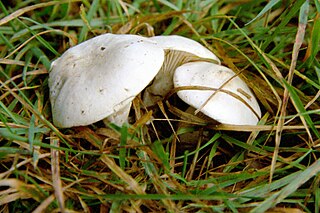
Amanita muscaria, commonly known as the fly agaric or fly amanita, is a basidiomycete of the genus Amanita. It is a large white-gilled, white-spotted, and usually red mushroom.

Muscarine, L-(+)-muscarine, or muscarin is a natural product found in certain mushrooms, particularly in Inocybe and Clitocybe species, such as the deadly C. dealbata. Mushrooms in the genera Entoloma and Mycena have also been found to contain levels of muscarine which can be dangerous if ingested. Muscarine has been found in harmless trace amounts in Boletus, Hygrocybe, Lactarius and Russula. Trace concentrations of muscarine are also found in Amanita muscaria, though the pharmacologically more relevant compound from this mushroom is the Z-drug-like alkaloid muscimol. A. muscaria fruitbodies contain a variable dose of muscarine, usually around 0.0003% fresh weight. This is very low and toxicity symptoms occur very rarely. Inocybe and Clitocybe contain muscarine concentrations up to 1.6%.

Mushroom poisoning is poisoning resulting from the ingestion of mushrooms that contain toxic substances. Symptoms can vary from slight gastrointestinal discomfort to death in about 10 days. Mushroom toxins are secondary metabolites produced by the fungus.

Clitocybe is a genus of mushrooms characterized by white, off-white, buff, cream, pink, or light-yellow spores, gills running down the stem, and pale white to brown or lilac coloration. They are primarily saprotrophic, decomposing forest ground litter. There are estimated to be around 300 species in the widespread genus.

Inosperma erubescens, and also commonly known as the deadly fibrecap, brick-red tear mushroom or red-staining Inocybe, is a poisonous basidiomycete fungus, one of many in the original genus Inocybe and one of the few known to have caused death. It is found growing in small groups on leaf litter in association with beech. All mushroom guidebooks as well as mushroom hunters advise that the entire Inocybaceae should be avoided for consumption. The fruit bodies appear in spring and summer; the bell-shaped caps are generally pale pinkish in colour with red stains, which can also be seen on the stipe and gills.

Entoloma sinuatum is a poisonous mushroom found across Europe and North America. Some guidebooks refer to it by its older scientific names of Entoloma lividum or Rhodophyllus sinuatus. The largest mushroom of the genus of pink-spored fungi known as Entoloma, it is also the type species. Appearing in late summer and autumn, fruit bodies are found in deciduous woodlands on clay or chalky soils, or nearby parklands, sometimes in the form of fairy rings. Solid in shape, they resemble members of the genus Tricholoma. The ivory to light grey-brown cap is up to 20 cm (7.9 in) across with a margin that is rolled inward. The sinuate gills are pale and often yellowish, becoming pink as the spores develop. The thick whitish stem has no ring.

Hygrophoropsis aurantiaca, commonly known as the false chanterelle, is a species of fungus in the family Hygrophoropsidaceae. It is found across several continents, growing in woodland and heathland, and sometimes on woodchips used in gardening and landscaping. Fruit bodies (mushrooms) are yellow–orange, with a funnel-shaped cap up to 8 cm across that has a felt-like surface. The thin, often forked gills on the underside of the cap run partway down the length of the otherwise smooth stipe. Reports on the mushroom's edibility vary – it is considered poisonous, but has historically been eaten in parts of Europe and the Americas.

Collybia personata is a species of edible fungus commonly found growing in grassy areas across Europe and is morphologically related to the wood blewit Collybia nuda. This mushroom was moved to the genus Collybia in 2023.

Tricholoma pardinum, commonly known as spotted tricholoma, tiger tricholoma, tigertop, leopard knight, or dirty trich, is a gilled mushroom widely distributed across North America, Europe, and parts of Asia. It is generally found in beech woodland in summer and autumn. Two subspecies have been described from southern Europe. First officially described by Christiaan Hendrik Persoon in 1801, T. pardinum has had a confusing taxonomic history that extends over two centuries. In 1762, German naturalist Jacob Christian Schäffer described the species Agaricus tigrinus with an illustration corresponding to what is thought to be T. pardinum, and consequently, the name Tricholoma tigrinum has been used erroneously in some European field guides.

Marasmius oreades, also known as the fairy ring mushroom, fairy ring champignon or Scotch bonnet, is a mushroom native to North America and Europe. Its common names can cause some confusion, as many other mushrooms grow in fairy rings, such as the edible Agaricus campestris and the poisonous Chlorophyllum molybdites.

Lepiota brunneoincarnata, the deadly dapperling, is a gilled mushroom of the genus Lepiota in the order Agaricales. Widely distributed in Europe and temperate regions of Asia as far east as China, it grows in grassy areas such as fields, parks and gardens, and is often mistaken for edible mushrooms. The mushroom has a brown scaled cap up to 4 cm wide with a pinkish brown stem and white gills. It is highly toxic, with several deaths having been recorded as it resembles the edible grey knight and fairy ring champignon.

Clitocybe rivulosa, commonly known as the false champignon or fool's funnel, is a poisonous basidiomycete fungus of the large genus Clitocybe. One of several species similar in appearance, it is a small white funnel-shaped toadstool widely found in lawns, meadows and other grassy areas in Europe and North America. Also known as the sweating mushroom, it derives this name from the symptoms of poisoning. It contains potentially deadly levels of muscarine.

Clitopilus prunulus, commonly known as the miller or the sweetbread mushroom, is an edible pink-spored basidiomycete mushroom found in grasslands in Europe and North America. Growing solitary to gregarious in open areas of conifer/hardwood forests; common under Bishop pine along the coast north of San Francisco; fruiting shortly after the fall rains. It has a grey to white cap and decurrent gills.

Inocybe geophylla, commonly known as the earthy inocybe, common white inocybe or white fibercap, is a poisonous mushroom of the genus Inocybe. It is widespread and common in Europe and North America, appearing under both conifer and deciduous trees in summer and autumn. The fruiting body is a small all-white or cream mushroom with a fibrous silky umbonate cap and adnexed gills. An all-lilac variety lilacina is also common.

Ampulloclitocybe clavipes, commonly known as the club-foot or club-footed clitocybe, is a species of gilled mushroom from Europe and North America. The grey brown mushrooms have yellowish decurrent gills and a bulbous stalk, and are found in deciduous and conifer woodlands. Although considered edible, disulfiram-like reactions have been reported after consumption of alcohol after eating this mushroom.

Aspropaxillus giganteus, also Leucopaxillus giganteus, commonly known as the giant leucopax or the giant funnel, is a saprobic species of fungus in the order Agaricales. As its common names imply, the fruit body, or mushroom, can become quite large—the cap reaches diameters of up to 50 cm (20 in). It has a white or pale cream cap, and is funnel-shaped when mature, with the gills running down the length of the stem. Considered by some to be a choice edible when young, this species has a cosmopolitan distribution, and is typically found growing in groups or rings in grassy pastures, roadside hedges, or woodland clearings. It has been shown to contain a bioactive compound with antibiotic properties.

Infundibulicybe geotropa, also known as the trooping funnel or monk's head, is a funnel-shaped toadstool widely found in Europe and in North America. A large sturdy cream- or buff-coloured funnel-shaped mushroom, it grows in mixed woodlands, often in troops or fairy rings, one of which is over half a mile wide. Although edible, it could be confused with some poisonous species of similar colouration and size.

Inocybe godeyi is a species of Inocybaceae fungus found in Europe. The species produces mushrooms with cone-shaped caps up to 5 cm (2 in) in diameter. The caps are cream, becoming browner, but they bruise red. The stem is up to 6 cm (2 in) long, and has a "bulb" at the base. The white flesh has a strong smell and an acrid taste. The mushrooms can be found on forest floors in autumn months; the species forms an ectomycorrhizal relationship to surrounding trees, favouring beech. I. godeyi is known to be poisonous, containing muscarine compounds, and consumption of the mushrooms can lead to SLUDGE syndrome. The species is sometimes mistaken for the deadly I. erubescens.

Paralepista flaccida is a species of mushroom found across the Northern Hemisphere. It is known to form fairy rings.

Infundibulicybe gibba, and commonly known as the common funnel or funnel cap, is a species of gilled mushroom which is common in European woods.




















